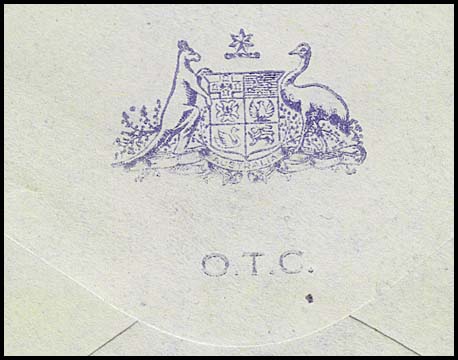Overseas Telecommunications Commission (OTC).
- Australia 1901-1988
- New South Wales
- Overview of NSW
- Telegraph lines
- Telegraph Offices
- Date stamps
- Forms
- Envelopes
- Instructional annotation
- Collect
- Delayed
- Free
- Immediate Urgent
- Reply paid
- Rates
- Stamps
- 1871 Telegraph stamps
- 1885 proposal
- 1893 proposal
- Queensland
- South Australia
- Tasmania
- Victoria
- Western Australia
- International
- Special aspects
| World War 2 confirmed the centrality of communication services to national self-reliance and the key role of Government in the provision of quality services. In August 1946, the Chifley Labor Government passed the Overseas Telecommunications Bill and established the Overseas Telecommunications Commission (Australia) – the OTC. It ended the long alliance between private ownership and Government (mainly that of England) and brought Australia’s international telecommunications under Australian control.
The UK-based Cable and Wireless authority was replaced by a strategic marriage between the Postmaster-General’s Department and the OTC. The OTC also inherited all AWA operations. Other countries of the British Empire also sought to take control of their international telecommunications by establishing similar Commissions and so moved away from centralised control of the Empire’s international telecommunications systems by London. |
 The OTC crest on the flap of an envelope posted on 6 March 1947. |
OTC was then responsible for all foreign telecommunication services in Australia including:
- coastal radio stations;
- AWA’s Beam Wireless stations and cable connections;
- the cable traffic;
- the international telephone system.
Satellite communication to other countries was introduced with INTELSAT II in 1966. Messages could be lodged at Post Offices and/or OTC gateway exchanges from which they were sent to the international circuits and the various satellite transmission dishes scattered around Australia.
The PMG’s Department was still responsible for within-Australia communications and for all land lines and their connection to the overseas facilities.
In 1992, the OTC merged with the Australian Telecommunications Corporation into the short-lived Australian and Overseas Telecommunications Corporation (AOTC). This Corporation continued to trade under the established identities of Telecom (for domestic telecommunications) and OTC (for international communications). The AOTC was renamed to Telstra Corporation Limited in 1993.
A variety of telegraphic services was offered. Consequently new telegram forms with the OTC heading were issued from about 1948 although other stationery, including envelopes, were printed from 1947.
Rates for international communications were established and revised.